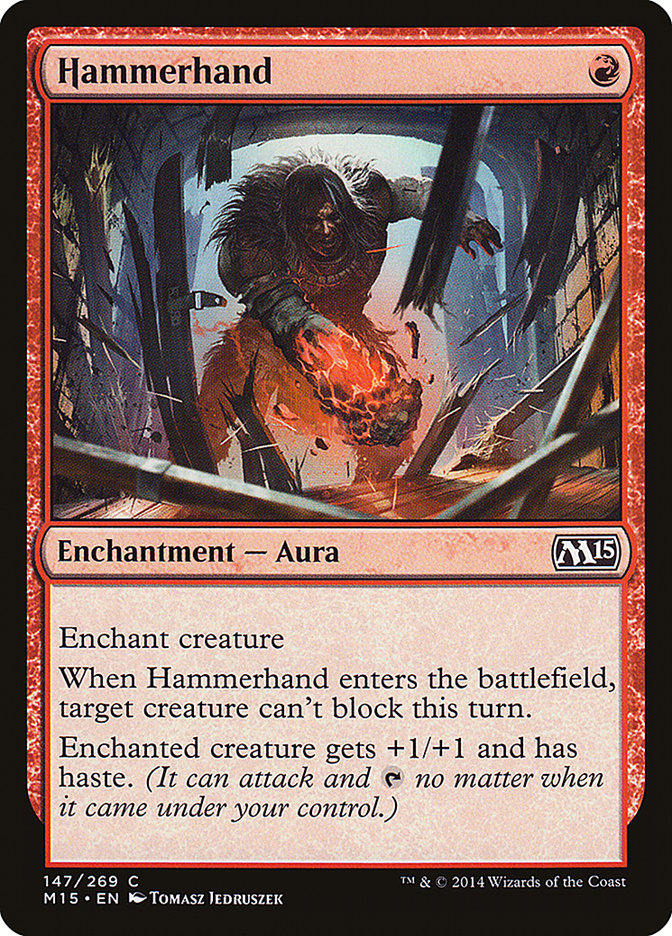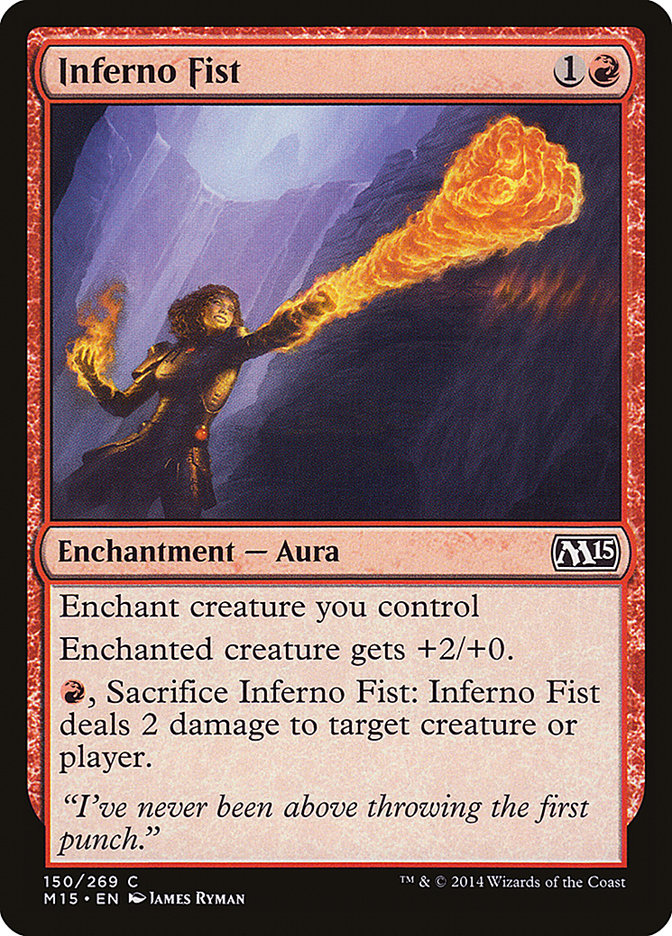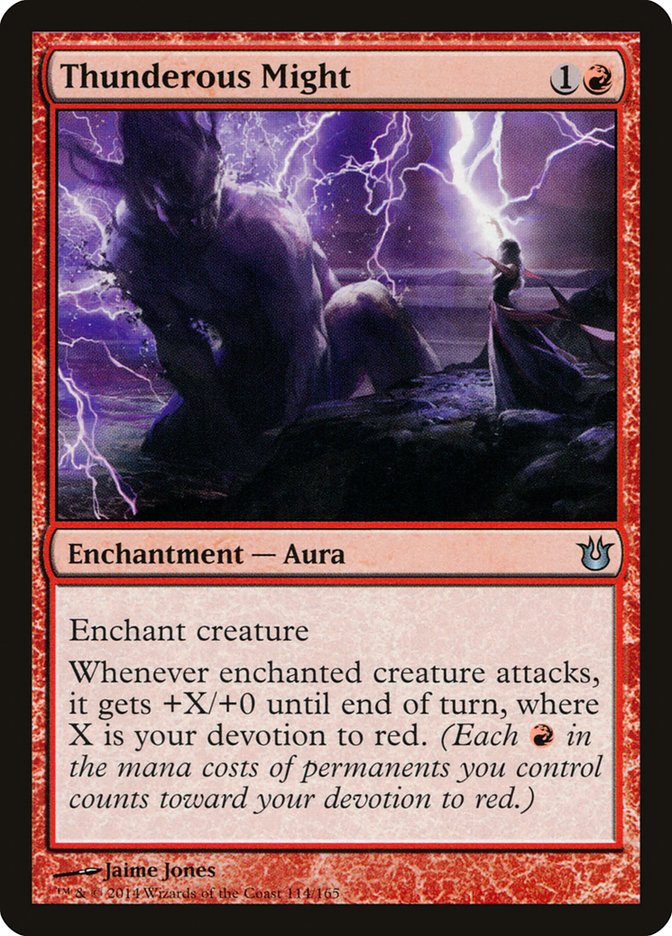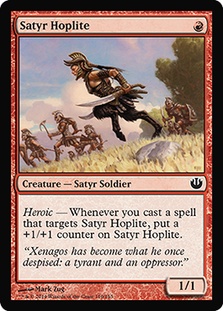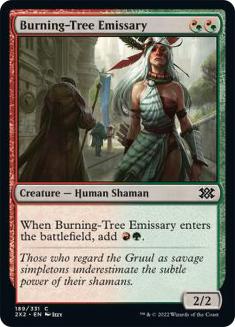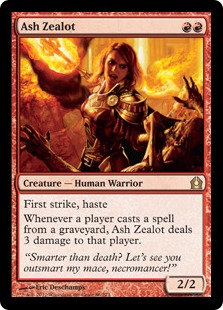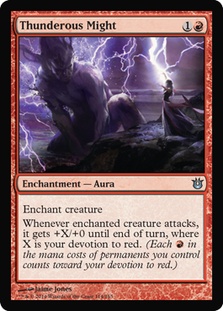Last summer, I sold off the vast majority of my Standard collection, from my sets of Thragtusks and Liliana of the Veil to my full sets of Ravnica shock
lands. It was nice to not carry around binders full of carefully organized cards, rip sleeve after sleeve as I changed decks, and wonder if I “had that one
card” buried in boxes at home. It’s been nice to live the lean life.
That is, until you want to build something.
Nowadays, I normally do my testing one of three ways: “goldfish” a bunch of times on my iPhone, sleeve up a papered proxy deck and sling it with
understanding shop pals, or go to MTGO and play there. This is usually enough to suffice; the deck shows itself to be decent, good, or bad, and it gives
some hint on ways to improve it.
MTGO is usually my preferred method, but between the lag time of M15 in paper and online Magic and shifting to the new client, I’ve felt a bit disconnected
from testing. My computer, a hodge-podge of Windows XP, aftermarket parts, and cacophonous fans, does not run the new client. Paper proxies were, frankly,
almost cheating, and goldfishing doesn’t give honest results because I know both hands and strategies at all times. This left one final option: build for
real.
The Life Cycle of a Standard Deck
I couldn’t shake it anymore; I decided to return to the world of paper to buy purpose-made parts for a new deck. But what to build? I flipped through my
leftovers from my M15 sealed pool from a few weeks ago, searching for a starting point.
Yisan, the Wanderer Bard? No… Necromancer’s Stockpile? Not quite… Fugitive Wizard? Maybe…
Hmm…
I’d loved playing with Hammerhand in Limited. This card is as tempo-y as red can get; preventing blocking (allowing a cleaner attack), adding power, and
granting haste are all things red loves to do. Tie them up in a one-mana enchantment and you have one of the more powerful red commons from the new set.
Inferno Fist was also a winner; the utility of adding power but having the option to Shock at will with no hand seems powerful.
Whoa, I’d totally forgotten about this card! With every other devotion spell seeing some kind of play, where’s the love for this one? With some heavy-red
support, this can be miles ahead of other 1R enchantments like Madcap Skills. Evasion be damned!
My hands were quivering, my mind was racing. I’d gotten…
Step 1: The Spark
Naturally, Hammerhand seems like a great heroic card. Playing a good heroic card and following it up with something that swings the attack equation two
units (they lose a blocker and you gain an attacker) might be the backbreaking play that makes a fringe heroic strategy function consistently. The two red
heroic one drops got added to the shell, then other powerful red aggro critters followed. If we keep it to red, we can keep the cost down and maybe even
skip the Mutavaults. In a few short minutes, I had the first draft of the deck.
Creatures (24)
- 4 Ash Zealot
- 4 Burning-Tree Emissary
- 4 Akroan Crusader
- 4 Firedrinker Satyr
- 4 Satyr Hoplite
- 4 Mogis's Warhound
Lands (20)
- 20 Mountain
Spells (16)

This deck was cheap and loaded with bears with triggers, getting sideways, and lots of damage. Exactly twenty one-mana spells, exactly twenty two-mana
spells and twenty Mountains; you can’t get much simpler.
I built this list and drew a starter hand, played out a mental game, then started over. I kid you not, I repeated this probably a hundred times and it never stopped being fun. I was getting hands like this:
Turn 1 Satyr, turn 2 Emissary, Thunderous Might on the Satyr, trigger, hit you for six. Turn 3 play Ash Zealot, hit for 12. Your opponent will be dead
before they resolve one Divination, and this particular hand is possible with a mull to five on the play. You might say this is Magical Christmasland™, but
this happened frequently over my three-digit testing spree.
Step Two: The Cuts
As I played this list, it almost felt like chess; there were a finite number of sequences possible for any given hand and board state. There were only ten
unique spells in the deck, and some proved terrible when redundant. The deck was still fun, but it needed some variety, some additional angles to make the
deck more interesting, and to give red something it rarely has: options.
Some cards proved to be troublesome. Satyr Hoplite, for example, was almost always worse than Akroan Crusader. Slimming it down to two felt right,
and blockers became problematic, so I added Frenzied Goblin in the free slots. Inferno Fist turned out to be a three-drop most of the time; I never felt
good playing it on two because I felt like I was giving up value. It also wasn’t Thunderous Might, which always matched Inferno Fist (guaranteed one
devotion for itself and at least one for the creature it enchants). It’s usually at this point that it’s good to add a sideboard to force the consideration
of good and bad matchups.
With some wiggling and variety injection, here’s the second version.
Creatures (24)
- 2 Frenzied Goblin
- 4 Ash Zealot
- 4 Burning-Tree Emissary
- 4 Akroan Crusader
- 4 Firedrinker Satyr
- 2 Satyr Hoplite
- 4 Mogis's Warhound
Lands (20)
- 20 Mountain
Spells (16)

Step Three: The Acquisition
Enough goldfishing; it was time to get the list! Not a moment after finishing the second version, I tiptoed online to price and buy the list (it was well
after 1 AM).
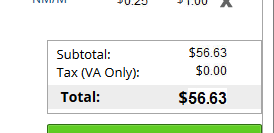
What a deal! This includes every piece of the deck including lands. Add a few bucks for sleeves and you’ve got a deck for less than the price of your cell
phone bill or a playset of Mutavaults! Even the fully foiled-out version (minus the insane foil Eidolon of the Great Revel) hovered around $130.
Step Four: The Tweak
I got my cards, sleeved them up, and tested when I could, and it became clear which cards were good and which were just taking up space. Satyr Hoplite was
never an exciting heroic target, and if you consider that Rakdos Cackler is a Satyr Hoplite with one free trigger, forcing that plan becomes much less
appealing. After a couple micro tweaks and one-dollar purchases from the shop, I settled on this list.
Creatures (24)
- 1 Frenzied Goblin
- 4 Ash Zealot
- 4 Burning-Tree Emissary
- 3 Foundry Street Denizen
- 4 Akroan Crusader
- 4 Firedrinker Satyr
- 4 Mogis's Warhound
Lands (20)
- 20 Mountain
Spells (16)
- 1 Madcap Skills
- 1 Barrage of Expendables
- 4 Dragon Mantle
- 4 Thunderous Might
- 1 Stoke the Flames
- 1 Crowd's Favor
- 4 Hammerhand
Sideboard

Found it!
Creatures
Akroan Crusader is a full head above Satyr Hoplite in terms of board presence and quality. While a heroic trigger does provide you the same power on each,
making an additional creature is so much better. The things that Satyr Hoplite is strong against (toughness-based removal, mainly) are irrelevant
when you consider that, when the Hoplite dies, you get nothing, while the Crusader leaves pals behind. Firedrinker Satyr is still better than something
like Rakdos Cackler because of the respect its firebreathing ability demands when they’re on low life and the ability to block. I’ve seen a lot of Rakdos
Cackler topdecks come down as 1/1 chump blockers and very rarely has anyone won that game. The other one drops got significantly shuffled. Frenzied Goblin,
while appearing to be a one drop, is really best around turns 4 and later. Foundry Street Denizen, on the other hand, is good all the time. Paired with
Burning-Tree Emissary and Akroan Crusader, this little goblin will often be a Savannah Lions or better.
The number of Burning-Tree Emissaries, Ash Zealots, and Mogis’s Warhound never moved. “BTE” casts a fair number of spells off its trigger, including a
one-drop, if you need it. Ash Zealot is a great early or late game threat. It can’t be blocked by Mutavault or even Pack Rat particularly well if you have
mana up. Mogis’s Warhound is often going to be a three-drop, but if you’re short on lands or just need a creature, this does the job. Bear in mind that the
Warhound is basically Ash Zealots five-eight; it adds two instant power, has semi-haste if the creature it enchants is later killed, and is great after an
emergency sweeper.
Spells
Dragon Mantle is amazingly crucial. The ability to cycle in this color is really powerful, and twenty Mountains is still enough to flood. I definitely like
it best on Akroan Crusader or Ash Zealot. Hammerhand was also perfect. There are plenty of Firedrinker Satyr into Crusader plus Hammerhand hands that will
show you how strong this card. Hammerhand feels good every time you cast it. One, two, or three of its abilities will always be relevant, I guarantee!
Thunderous Might is a weird one, but I will tell you that it is potentially the most powerful spell in this deck. It can single
handedly bring your opponent from fifteen to four. Your devotion will usually hover around four or five, with every Burning-Tree Emissary adding two free
power!
Inferno Fist vanished; I so rarely cast it with the spare mana up that I figured that anything else would be better. Turns out Madcap Skills was exactly
that. Many lists play several of these, but I feel like this effect is an important one to have but not to jam every time.
Crowd’s Favor looks kind of strange. Two more powerful variants of this card exist in the format: Weapon Surge and Coordinated Assault. However, Crowd’s
Favor is a one-time, super critical trick that your opponent will never prepare for. Burning-Tree Emissary lets you get aggressive with that turn
1 X/1, but it can provide that perfect tempo play to knock out their big player. One is enough; once they’ve seen it, they’ll be tempted to play around it
for the rest of the match.
Stoke the Flames is a card I’ve been dying to try, and with all the little critters we’ve got rattling around in the list, it’s very likely we can cast it
after just a couple turns. A Burning-Tree Emissary on turn 3 is enough to power it out by herself (her trigger, your third Mountain, and the convoke
mechanic to tap her). As Boros Charm and Flame Rift has proven, four damage is a lot of damage to the face.
Barrage of Expendables adds a devotion for Thunderous Might, but it also provides a late-game finisher as well as a way to turn Akroan Crusader tokens into
a machine gun against small creatures.
Lands
Twenty Mountains always seemed to be the right number–no more, no less. No non-basic land could persuade me from the consistency of good old [R].
Sideboard
The sideboard shifted around to make itself as consistent as possible. Eidolon of the Great Revel comes in against the slow matches. This seemed
counterintuitive to me at first, but they’re siding in all their removal for you, and you’re under very little pressure in the early game. Casting the
Eidolon basically allots you ten spells before death. Getting these out in multiples is insane against a deck that’s trying to Doom Blade or Last
Breath your creatures. Searing Blood is my one angle to do even better against the aggro decks. This is a great tempo swing that kills anything from a
Mutavault to a Pack Rat to a Boon Satyr. The three damage to the face is potentially the biggest selling point. Speaking of three to the face, Skullcrack
appears against any deck with Gray Merchant of Asphodel, Sphinx’s Revelation, or some other burst lifegain ability. If you’re doing your job, they’re often
in their death throes when they cast the necessary lifegain spell to get ahead. It’s also hilarious against a deck with Fog. Finally, three more Stoke in
Flames come in; I feel like they will provide immense, efficient reach in a deck where I can get them down to seven or eight but no farther.
I can’t wait to try it out in a real tournament environment. Game Day seems perfect. It’s not too competitive, but people are still there to win.
Step Five: The Test
While Game Day looms just a few days away, it was time to put this to the test. I sparred with as many decks as I had time to. Here were my best matchups:
Best Matchups: Mono-Black Aggro, U/W Control, B/X Midrange
Mono-Black Aggro, to me, felt like an inferior red deck, but with Thoughtseize. Without the Emissary or a way to reach in the long game, I couldn’t lose
with a good hand. U/W Control was also putty in my hands with a good opener. An on-time Detention Sphere was about all that could spare them. Thanks to the
power boosts, Jace, Architect of Thought wasn’t that helpful. Post-board, Eidolons devoured U/W, punishing them for even the smallest removal spell.
B/X Midrange (I played a white and a green version) needed to have an on-time Bile Blight to trip me up. The B/W version was better against me, but that
mostly involved stalling until my opponent resolved Elspeth, Sun’s Champion. Green was much easier; Abrupt Decays were often synonymous with Ultimate
Price, and the planeswalker suite is less impactful.
Worst Matchups: Mirror, Mono-Blue Devotion, Mono-Green
On the other hand, I had a lot of difficulty with other Ash Zealots and Burning-Tree Emissaries. Many traditional Mono-Red lists have two-toughness
creatures, meaning I usually can’t trade one-for-one in the likely situations that I’m supposed to block. Like with all Mono-Red aggro mirrors, tempo is
key. Getting to the point where your opponent can’t get completely in the red zone is where you want to be. In my case, the ace up my sleeve is Thunderous
Might; in the games I did win, it was frequently off a backswing with this card.
Mono-Blue and Mono-Green Devotion are both similar in their game plan to stop me: gum up the ground. Master of Waves is a terrific force considering I lack
a lot of maindeck removal, and an on-curve Master pretty much puts me out of the game. I still haven’t developed a good strategy to fight this deck, but
I’m working on it. Mono-Green does much the same thing, but it also has the immense power of ringers like Polukranos, World Eater. If my opponent untaps
with Polukranos, it’s all over.
The final test, of course, is this weekend’s Game Day, and as of now, it looks like there’s still a bit of work to be done. I fiddled with the deck one
last time to come up with this.
Creatures (24)
- 4 Ash Zealot
- 4 Burning-Tree Emissary
- 4 Foundry Street Denizen
- 4 Akroan Crusader
- 4 Firedrinker Satyr
- 4 Mogis's Warhound
Lands (18)
- 18 Mountain
Spells (18)
- 1 Gather Courage
- 1 Madcap Skills
- 1 Barrage of Expendables
- 4 Dragon Mantle
- 4 Thunderous Might
- 2 Stoke the Flames
- 1 Crowd's Favor
- 4 Hammerhand
Sideboard

Even with just twenty lands, I still found myself flooding, and considering I had two “free” spells, I felt like slimming down was acceptable. Gather
Courage, while only playable off a Burning-Tree Emissary, seems like a super-cute but highly potent singleton to provide a nice, non-red effect. Who knows,
it may be too adorable.
Frenzied Goblin turned out to be a trap; I’m not sure if the format can support this guy. Maybe a Goblin deck could, but a generic red deck can’t afford a
1/1 that you have to commit more mana to after resolving it.
I moved the Stoke in Flames completely to the maindeck; I sided them in every time. I replaced their sideboard slots with a jumble of Shock and
Electrickery, both of which have great applications in a match with multiple X/1s.
I’ll let you know how it goes; this deck was almost a bit too traditional to me, so I’ll be anxious to get back to an exciting set of brews next week.
What’s the cheapest deck you’ve ever played in Standard? How’d it do?

